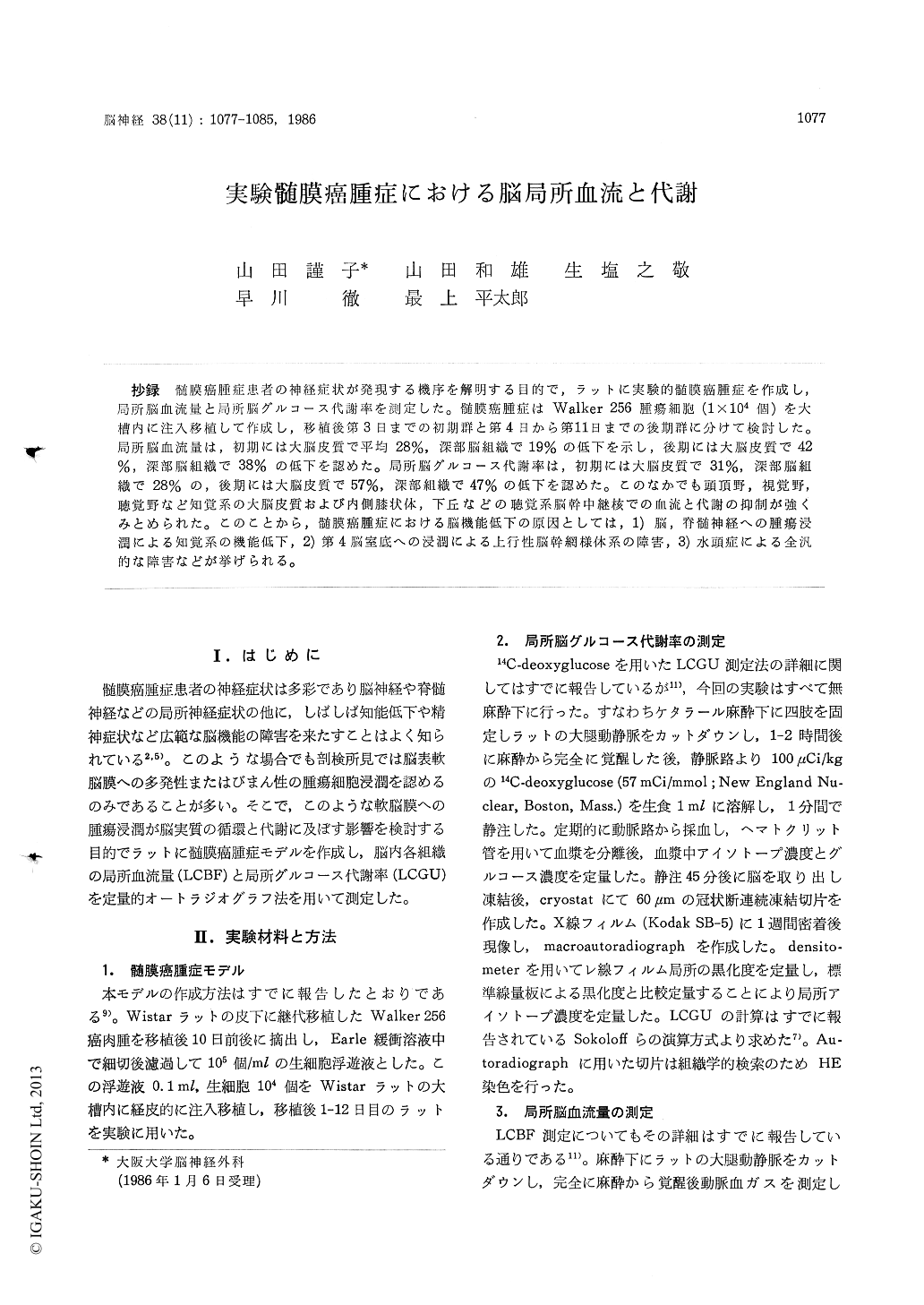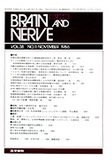Japanese
English
- 有料閲覧
- Abstract 文献概要
- 1ページ目 Look Inside
抄録 髄膜癌腫症患者の神経症状が発現する機序を解明する目的で,ラットに実験的髄膜癌腫症を作成し,局所脳血流量と局所脳グルコース代謝率を測定した。髄膜癌腫症はWalker256腫瘍細胞(1×104個)を大槽内に注入移植して作成し,移植後第3日までの初期群と第4日から第11日までの後期群に分けて検討した。局所脳血流量は,初期には大脳皮質で平均28%,深部脳組織で19%の低下を示し,後期には大脳皮質で42%,深部脳組織で38%の低下を認めた。局所脳グルコース代謝率は,初期には大脳皮質で31%,深部脳組織で28%の,後期には大脳皮質で57%,深部組織で47%の低下を認めた。このなかでも頭頂野,視覚野,聴覚野など知覚系の大脳皮質および内側膝状体,下丘などの聴覚系脳幹中継核での血流と代謝の抑制が強くみとめられた。このことから,髄膜癌腫症における脳機能低下の原因としては,1)脳,脊髄神経への腫瘍浸潤による知覚系の機能低下,2)第4脳室底への浸潤による上行性脳幹網様体系の障害,3)水頭症による全汎的な障害などが挙げられる。
Patients with meningeal carcinomatosis often evolve signs of impairment in higher mental func-tion. Yet, common findings of histological obser-vation are only a sheet of tumor cells on the cortical surface, and no intracerebral mass are noted. To elucidate mechanism of mental disturb-ances in meningeal carcinomatosis, local cerebral blood flow and glucose metabolism were evaluated in a model of experimental meningeal carcinoma-tosis.
Viable cells (1×104) of Walker 256 tumor were inoculated into cisterna magna of Wistar rats. Animals were used for autoradiographic study at 1 to 12 days after tumor inoculation. Local cerebral glucose utilization (LCGU) and local cerebral blood flow (LCBF) were measured with quantitative au-toradiographic technique using 14C-iodoantipyrine and 14C-deoxyglucose as a tracer, respectively.
In the early stage of tumor growth (1 to 3 days after tumor inoculation), reduction of LCGU was averaged to be 31% in the cerebral cortex and 28% in the deep structures, whereas reduction of LCBF was 28% in cerebral cortex and 19% in deep structures on average. In the late stageof tumor growth (4 to 12 days after tumor inocula-tion), average reduction of LCGU was 57% in the cerebral cortex and 47% in the deep struc-tures. On the other hand, reduction of LCBF was averaged to be 42% in the cerebral cortex and 38% in the deep structures in the late stage of the disease. Reduction of LCGU and LCBF was especially evident in the sensory cortices such as parietal cortex, visual cortex and auditory cortex, and in the auditory centers of the brain stem such as medial geniculate body and inferior colliculus. There was no definite evidence that blood flow and glucose metabolism of the cortex underneaththe sheet of tumors were suppressed by the tumor.
Coupled suppression of blood flow and glucose metabolism during the early stage of tumor growth was probably the result of diffuse cortical sup-pression due to mild hydrocephalus and increase in intracranial pressure. Suppression of glucose metabolism during the late stage was probably the result of suppression of sensory system due to tumor invasion to the cranial nerves and spinal roots, and the result of impairment in the ascend-ing reticular activating system by direct invasion of the tumor to the floor of the fourth ventricle.

Copyright © 1986, Igaku-Shoin Ltd. All rights reserved.


